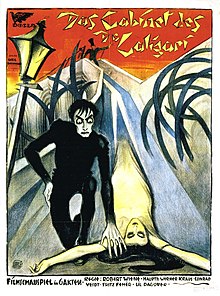 Title: The Cabinet Of Dr Caligari
Title: The Cabinet Of Dr Caligari
Rating: 5 Stars
I’m taking a little dip into silent films. This is one of the all time classics.
The film starts with an older man complaining to a younger man about how spirits are haunting him. The younger man says hold my beer and proceeds to tell his story.
The man (Francis) and his best friend Alan both have a thing for Jane. The three of them plan to visit their local town fair in Holstenwall. One of the performers there is Dr Caligari. He goes to the town clerk to get a permit. When the rude clerk asks what he will present, he says that it will be a somnambulist (a sleepwalker). The clerk laughs at him. Later that night, the clerk is stabbed and murdered.
Francis and Alan attend Dr Caligari’s act. The somnambulist (named Cesare) awakens and claims to know the future. Alan takes him up on it and asks Cesare how long he will live. Cesare says that Alan will not survive the night. That night, Alan is stabbed and murdered.
Francis, fairly obviously, thinks that this is an open and shut case. However, a thief has just been caught trying to stab a lady, so he’s arrested and thrown in jail, so no one besides Francis suspects Cesare. Meanwhile, Jane has a little meeting with Dr Caligari and Cesare and she runs away terrified. Still suspicious, Francis stakes out Dr Caligari’s room and apparently sees Cesare happily sleeping. Later that night, Jane wakes up to Cesare looming over her with a knife. Terrified, she cries out. She is not stabbed but Cesare carries her off into the night. The townspeople give chase. Cesare drops Jane but keeps running until he collapses, dead.
Francis, hearing about the attack, is dumbfounded. He, with the police, bursts into the doctor’s room. It turns out that what he thought was Cesare was actually a dummy. The doctor gets away in the confusion.
Francis is able to track him to the local insane asylum. There he learns that the doctor is the director of it. Francis does some investigation and he discovers that the doctor is obsessed with an ancient monk (named Caligari) that was able to control a somnambulist (named Cesare). The doctor became obsessed with replicating the monk’s experiments, and when a somnambulist patient was admitted to the asylum, he saw his big chance. When all of this is discovered, the doctor fights violently but is overpowered, strapped into a straitjacket, and placed in a cell.
But wait. As Francis is now (in the present day) wrapping up this tale, it becomes apparent that Francis is the one that is in the insane asylum. The director of the asylum is the very same doctor that Francis thinks is Caligari. Horrified, Francis attacks him. Now it’s Francis that is strapped into a straitjacket and locked in a cell. The director says now that he understands Francis’ obsessions, that he can treat him. The film fades out with a closeup on what can only be described as an enigmatic look on the good doctor’s face.
That’s a lot!
Why is this film, made in 1920, so acclaimed? Well, it’s one of the first examples, if not the actual first, of horror. The slow, lurching steps of Cesare with his arms straight out prefigure horror monsters like Frankenstein or The Mummy or even the zombies from The Night of the Living Dead. This might be the first appearance of story framing (basically having a story within a story).
Visually, it’s a completely new style. There are hardly any straight vertical lines in the film. Everything is askew. Doors are monstrous. Windows are broken and crooked. This is the first and probably most significant example of cinematic German Expressionism. Given that we’re talking 1920 Germany, it had an extremely low budget. In designing the set, this low budget was used to create the aesthetic.
A quick word about German Expressionism. In 1920, Germany had just lost World War I. The treaty of Versailles, forcing Germany to accept all blame for starting the war and shouldering it with massive indemnities, had just been signed. The German government was in a precarious place. Its economy was even more precarious.
Germans must have had feelings of angst, a sense of being lost, worried about the future, and thinking that nothing in the present made sense. This alienation is fully represented in German Expressionism and would later lead to the rise of the Nazi party.
Another thing that I liked about the film was its unreliable narration. You get sucked into the plot and then the rug is pulled out from under you. This prefigure films like Shutter Island, American Psycho, or even the film that I recently discussed, Frailty.
The Cabinet of Dr Caligari sets the path for future horror films by subtly commenting about the current zeitgeist. For example, in modern zombie films, the idea of mindless beings uncontrollably rushing in can be interpreted as a statement about American paranoia of being overwhelmed by illegal immigration that will somehow fundamentally change our way of life. In Caligari, the inner story is about a doctor taking over the mind and body of an inert sleepwalker. The doctor can be interpreted as state authority and the inert sleepwalker is the population. Considering how millions of Germans had just lost their lives fighting in a war at the behest of their Kaiser (even today, the motivations of WWI are murky at best), this message must have resonated to the German people of 1920.
I almost forgot the most important impact that the film had on future cinema. During the story, Dr Caligari constantly wears gloves. Take a very close look at those gloves. After you’ve done that, take a look at Mickey Mouse’s gloves.
They are the same gloves! Walt Disney totally stole Dr Caligari’s gloves! Someone call the copyright police!